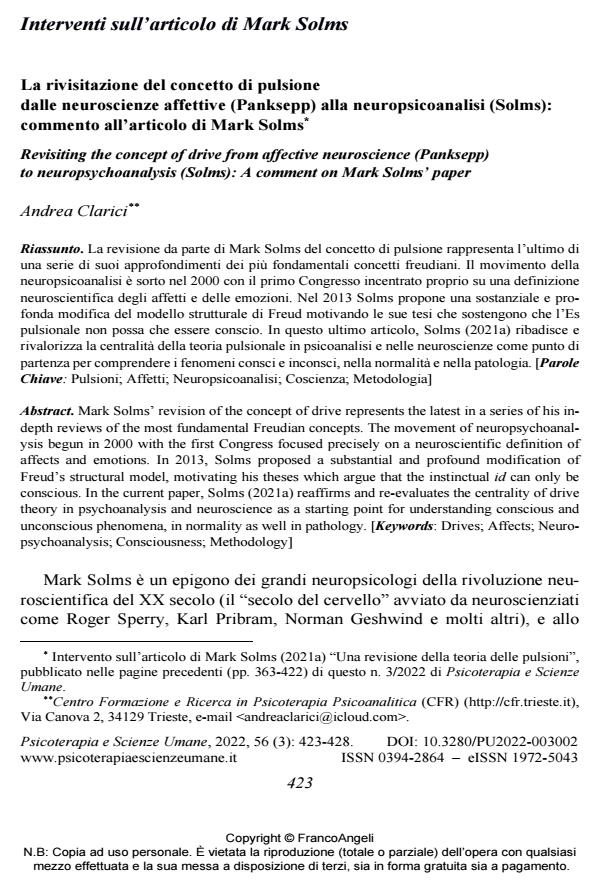Revisiting the concept of drive from affective neuroscience (Panksepp) to neuropsychoanalysis (Solms): A comment on Mark Solms’ paper
Journal title PSICOTERAPIA E SCIENZE UMANE
Author/s Andrea Clarici
Publishing Year 2022 Issue 2022/3
Language Italian Pages 6 P. 423-428 File size 34 KB
DOI 10.3280/PU2022-003002
DOI is like a bar code for intellectual property: to have more infomation
click here
Below, you can see the article first page
If you want to buy this article in PDF format, you can do it, following the instructions to buy download credits

FrancoAngeli is member of Publishers International Linking Association, Inc (PILA), a not-for-profit association which run the CrossRef service enabling links to and from online scholarly content.
Mark Solms’ revision of the concept of drive represents the latest in a series of his in-depth re-views of the most fundamental Freudian concepts. The movement of neuropsychoanalysis begun in 2000 with the first Congress focused precisely on a neuroscientific definition of affects and emotions. In 2013, Solms proposed a substantial and profound modification of Freud’s structural model, motivating his theses which argue that the instinctual id can only be conscious. In the current paper, Solms (2021a) reaffirms and re-evaluates the centrality of drive theory in psychoanalysis and neuroscience as a starting point for understanding conscious and unconscious phenome-na, in normality as well in pathology.
Keywords: Drives; Affects; Neuropsychoanalysis; Con-sciousness; Methodology
- Clarici A. (2015). Neuropsychoanalysis has an influence on psychoanalytic technique but not on the psychoanalytic method. Neuropsychoanalysis, 17, 1: 39-51. DOI: 10.1080/15294145.2015.1034291
- Clarici A. (2019). To be or not to be a neuropsychoanalyst... that is the question! In: Balchin R., Barry V., Bazan A., Blechner M.J., Clarici A., Flores Mosri D., Fotopoulou A., Goergen M.S., Kessler R., Matthis I., Muñoz Zúñiga J.F., Northoff G., Olds D., Oppenheim L., Reismann-Lagrèze D., Tsakiris M., Watt D., Yeates G. & Zellner M., Reflections on 20 years of neuropsychoanalysis. Neuropsychoanalysis, 2019, 21: 2: 97-100. DOI: 10.1080/15294145.2019.1695978
- Freud S. (1899 [1900]). L’interpretazione dei sogni. Opere, 3. Torino: Boringhieri, 1966.
- Freud S. (1915). Metapsicologia. Pulsioni e loro destini. Opere, 8: 13-35. Torino: Boringhieri, 1976.
- Freud S. (1922 [1923]). L’Io e l’Es. Opere, 9: 471-520. Torino: Boringhieri, 1977.
- Friston K. (2009). The free-energy principle: A rough guide to the brain? Trends in Cognitive Sciences, 13, 7: 293-301.
- Friston K. (2010). The free-energy principle: A unified brain theory? Nature Reviews Neuroscience, 11, 2: 127-138.
- Panksepp J. (1998). Affective Neuroscience: The Foundations of Human and Animal Emotions. New York: Oxford University Press
- Panksepp J. & Biven L. (2012). The Archaeology of Mind: Neuroevolutionary Origins of Human Emotions. Foreword by Daniel J. Siegel. New York: Norton (trad. it.: Archeologia della mente: origini neuroevolutive delle emozioni umane. Prefazione di Daniel J. Siegel. Postfazione di Andrea Clarici. Edizione italiana a cura di Andrea Clarici e Antonio Alcaro. Milano: Raffaello Cortina, 2014).
- Quinodoz J.M. (2013). Reading Freud: A Chronological Exploration of Freud’s Writings. London: Routledge.
- Sacks O. (1984). A Leg to Stand On. New York: Simon and Schuster (trad. it.: Su una gamba sola. Milano: Adelphi, 1991).
- Solms M. (2013). The conscious id. Neuropsychoanalysis, 15, 1: 5-85.
- Solms M. (2018). La coscienza dell’Es: psicoanalisi e neuroscienze. Cura e prefazione di Andrea Clarici. Milano: Raffaello Cortina.
- Solms M. (2021a). Revision of drive theory. Journal of the American Psychoanalytic Association, 69, 6: 1033-1091.
- Solms M. (2021b). Response to the commentaries. Journal of Consciousness Studies, 28, 11: 222-248.
Andrea Clarici, Interventi sull’articolo di Mark Solms. La rivisitazione del concetto di pulsione dalle neuroscienze affettive (Panksepp) alla neuropsicoanalisi (Solms): commento all’articolo di Mark Solms in "PSICOTERAPIA E SCIENZE UMANE" 3/2022, pp 423-428, DOI: 10.3280/PU2022-003002